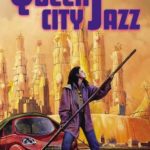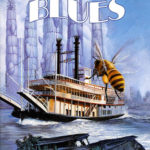Talk about Steven Spielberg’s Close Encounters of the Third Kind, and someone inevitably hums or whistles that famous five-note sequence created by John Williams for the film. A recent viewing of the film got me thinking about other intersections between music and science fiction. Music abounds in fantasy:
- Alex Bledsoe’s Tufa series
- King Rat, China Mieville
- The Name of the Wind, Patrick Rothfuss
- Signal To Noise, Silvia Moreno-Garcia
- The Singer’s Crown, Elaine Isaak
- Station Eleven, Emily St. John-Mandel
- Practically any Arthurian adaptation, because A) kings have bards, and B) Merlin as both bard and magician is integral to Arthur’s story
See how easy that was? I really ought to stop there or create a whole new post (hmmm). It was also easy to think of science fiction music, from Kraftwerk to Pink Floyd to Janelle Monae and They Might Be Giants (here’s a pretty great list at io9). But it was much more difficult for me to think of examples of science fiction books in which music is somehow integral to the plot or to the writing — stories that were about music, whose characters were musicians, or which made allusions to musical movements (not just in the story titles, either). It took some digging into my reading history to bring some titles to light.
Nanotech Cycle, Kathleen Ann Goonan. This series was actually the easiest to recall, so it gets top spot; it’s been years since I read these books but I can still tell you all about them. All four books in this series hearken back to musical patterns. Queen City Jazz (1994) and Mississippi Blues (1996) in particular contain some of the most lyrical writing, and Goonan’s imaginative worldbuilding remains original and haunting. The first entry, Queen City Jazz, is a quirky, creepy, beautiful trip through a surreal, dystopic U.S. forever changed by nanotech plagues, where cars and houses come to life, buildings grow from seeds, and gigantic bees pollinate buildings with information. Main character Verity, who grew up on an isolated Shaker farm in Ohio, travels through this terrain to take the comatose body of her best friend, Blaze, to the Enlivened city of Cincinnati, hoping he can be restored to life. Along the way a musician named Sphere forces Verity to confront her own identity and destiny. Goonan was unafraid to imagine a future completely transformed by nanotech in a myriad of ways. Mississippi Blues continues Verity’s story as she journeys to New Orleans ahead of another nanoplague; Crescent City Rhapsody (2000) evokes Octavia Butler’s Parable novels by following a nano-resurrected Marie Laveau, who presides over New Orleans and tries to find ways to use the nanotech to the city’s advantage in the new landscape; and Light Music (2002), in which people begin to disappear from the Earth, and the three remaining survivors try to figure out why.
 Crystal Singer Series, Anne McCaffrey. McCaffrey rode the line between fantasy and science fiction, so I’m counting Crystal Singer in this list. In Crystal Singer (1985), the first book, failed opera soloist Killashandra Ree casts about for a new direction. She embarks on a whirlwind romance with a man named Carrick who introduces her to the dangerous, high-stakes career of crystal singing. Killashandra’s ability to sing with perfect pitch would allow her to join the Heptite Guild and become a crystal singer — someone who mines the crystal that powers the systems everyone relies upon. The downside is that the crystal is native to a planet which produces a spore that causes genetic mutations. Only a few survive the infection; some become fully adapted, enjoying near-immortality and heightened senses that aid in the mining of crystal, but they can never leave the planet for long, or they will die. McCaffrey covers Killashandra’s exploits in two more books, Killashandra (1986, which I accidentally read first), and Crystal Line (I swear that’s a play on “crystalline”). Some say that the story is dated in places; some say the main character is pretty self-absorbed. But the end result is that McCaffrey wrote about a woman with ambitions who was not afraid to pursue them.
Crystal Singer Series, Anne McCaffrey. McCaffrey rode the line between fantasy and science fiction, so I’m counting Crystal Singer in this list. In Crystal Singer (1985), the first book, failed opera soloist Killashandra Ree casts about for a new direction. She embarks on a whirlwind romance with a man named Carrick who introduces her to the dangerous, high-stakes career of crystal singing. Killashandra’s ability to sing with perfect pitch would allow her to join the Heptite Guild and become a crystal singer — someone who mines the crystal that powers the systems everyone relies upon. The downside is that the crystal is native to a planet which produces a spore that causes genetic mutations. Only a few survive the infection; some become fully adapted, enjoying near-immortality and heightened senses that aid in the mining of crystal, but they can never leave the planet for long, or they will die. McCaffrey covers Killashandra’s exploits in two more books, Killashandra (1986, which I accidentally read first), and Crystal Line (I swear that’s a play on “crystalline”). Some say that the story is dated in places; some say the main character is pretty self-absorbed. But the end result is that McCaffrey wrote about a woman with ambitions who was not afraid to pursue them.
 After Long Silence, Sheri S. Tepper (1987). Since we’re talking crystals and music, this list isn’t complete without a Tepper book. Tepper is another author who wedded fantasy with science fiction, usually resulting in wonderfully ambiguous, weird, ecologically-focused tales that left me sometimes unsure of what I had read, but that I liked them and couldn’t forget them. After Long Silence is no exception. Humans colonizing the planet Jubal literally can’t go anywhere without encountering crystalline structures they call Presences. Their existence has divided the colonizers; some humans formed a cult to worship them, and others want to quite literally blow them up. Why? Because the Presences make travel and trade especially difficult. Only specially trained vocalists called Tripsingers, some who are members of that new weird cult, can guide travelers past or around Presences without shattering the crystals, but a different song must be found and sung for each Presence. There is one rule: never sing off-key, because a shattered crystal will reseed itself a thousand times over, with horrific results! No pressure. The problem is that it’s impossible to know whether or not the humans are actually communicating with the crystals, or if the Presences are sentient — and since there is gain to be had on Jubal, certain factions are not interested in answering that question.
After Long Silence, Sheri S. Tepper (1987). Since we’re talking crystals and music, this list isn’t complete without a Tepper book. Tepper is another author who wedded fantasy with science fiction, usually resulting in wonderfully ambiguous, weird, ecologically-focused tales that left me sometimes unsure of what I had read, but that I liked them and couldn’t forget them. After Long Silence is no exception. Humans colonizing the planet Jubal literally can’t go anywhere without encountering crystalline structures they call Presences. Their existence has divided the colonizers; some humans formed a cult to worship them, and others want to quite literally blow them up. Why? Because the Presences make travel and trade especially difficult. Only specially trained vocalists called Tripsingers, some who are members of that new weird cult, can guide travelers past or around Presences without shattering the crystals, but a different song must be found and sung for each Presence. There is one rule: never sing off-key, because a shattered crystal will reseed itself a thousand times over, with horrific results! No pressure. The problem is that it’s impossible to know whether or not the humans are actually communicating with the crystals, or if the Presences are sentient — and since there is gain to be had on Jubal, certain factions are not interested in answering that question.
Honorable Mention (aka I Haven’t Read It Yet):
Year Zero, Robert Reid (2012). A satire in which an about-to-be-fired copyright lawyer named Nick Carter (yes, like the Backstreet Boy) finds out that the universe loves our pop music so much that they’ve been stealing it. In fact, they’ve racked up so many fines that the universe is bankrupt — and Earth now owns everything. Reid’s book is said to be both a walk on the wild side and a pretty good explanation of how music copyright law actually works. Recommended for music nerds, people who like quirky reads, and people who like footnotes.
Dreaming Metal, Melissa Scott (1997). A cyberpunk adventure set in the world Scott introduced in Dreamships, this follows three different narrators, among them Fanning Jones and his cousin Celinde Fortune, all of whom arrive on the planet Persephone to perform for audiences on a planet rife with sociopolitical conflict. Fanning helps Celinde purchase parts that become the AI Celeste, whom Fortune uses in her illusionist act. It was recommended to me to read Dreamships first to get the background on the sociopolitical conflict, because that plays a huge part in the story.
Any other suggestions? Keep the chain going in the comments below!





I’ve not read any of these, and while I’m hard-pressed to think of an example, I want to say Mary Doria Russell’s THE SPARROW might maybe apply….. things weren’t what they seemed when it was all said and done, but I want to say the aliens on the other planet were initially considered “Singers.”
Kathleen Ann Goonan. Love her. I’ve read In War Times which I loved, and barring a short piece or two, nothing else, not yet. I do have Queen City Jazz hiding in my TBR though!
I forgot about “The Sparrow!” I haven’t ever made it all the way through that book. For reasons. I think you’re right.
When you read “Queen City Jazz”, let me know so we can dish.
Oh, you must finish reading it! It’s so, so wonderful, and it’s one of the best examples I’ve ever seen of an omniscient point of view.